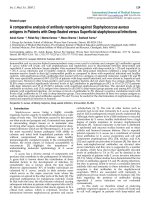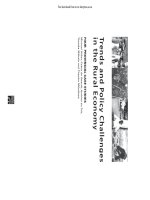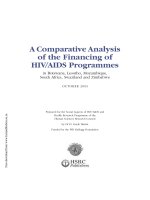Corruption and policy implementation in the philippine a comparative analysis of the teacher training and textbook delivery programmes at the department of education 2
Bạn đang xem bản rút gọn của tài liệu. Xem và tải ngay bản đầy đủ của tài liệu tại đây (1.19 MB, 17 trang )
341
Annex A:
Questionnaires for Semi-Structured Case Interviews Set 1
Textbook Delivery Programme (TDP)
Programmes addressing basic needs of Elementary and High School
A general set of inquiries has been drawn up. These questions will be modified
accordingly to suit the type of source informant being addressed. The areas of inquiry
have been set to try to address the main puzzles of the study, these are listed below:
1. How do national government agencies, non-government organizations and
International organizations work together in addressing the different issues related to
Programmes addressing basic needs of Elementary and High School students in a
Philippine setting?
1.1 What are the issues and challenges that accompany the working
relationship between government, civil society and International
Organizations?
1.2 Are there institutional structures built that allow for the regular
interaction of governments, civil society and International
Organizations?
2. Are there regular professional informative gatherings were various
organizations and individuals meet, discuss and acquire knowledge regarding the
issues on education reform in the Philippines?
2.1 Who organizes these professional gatherings? How often are they
held?
2.2 How effective are these professional gatherings in shaping policies of
governments with respect to Programmes addressing basic needs of
Elementary and High School students’ strategies in the Philippines?
3. Are there regular institutional meetings were various organizations and
individuals meet and discuss issues and challenges related to the education reform
issues?
3.1 Who organizes these institutional meetings? How often are they held?
3.2 How effective are these institutional meetings in shaping policies of
governments with respect to education reform strategies in the
Philippines?
4. What was your organization’s role in coming up with Programmes addressing
basic needs of Elementary and High School students?
342
4.1 What are the contributions of your organization to Programmes
addressing basic needs of Elementary and High School students? How
effective was the interaction that happened between your organization
and other entities in coming up with Programmes addressing basic
needs of Elementary and High School students?
4.2. What issues and challenges did your organization face in the
formulation and eventual ongoing implementation of Programmes
addressing basic needs of Elementary and High School students?
5. How have the Programmes addressing basic needs of Elementary and High
School students influenced the domestic politics of the country especially with regard
to education in the Philippines?
5.1. How prominent is the issue of Programmes addressing basic needs of
Elementary and High School students in the domestic politics of the
country where your organization functions?
5.2 Who are the “champions” and “sponsors” and what were the
“conditions” that enabled the enactment of Programmes addressing
basic needs of Elementary and High School students?
343
Annex A:
Questionnaires for Semi-Structured Case Interviews Set 2
Programme on Basic Education (PROBE)
Philippine and Australian Government Project in Basic Education
A general set of inquiries has been drawn up. These questions will be modified
accordingly to suit the type of source informant being addressed. The areas of inquiry
have been set to try to address the four main puzzles of the study, these are listed
below:
1. How do national government agencies, non-government organizations and
International organizations work together in addressing the different issues related to
education reform in a Philippine setting?
1.1 What are the issues and challenges that accompany the working
relationship between government, civil society and International
Organizations?
1.2 Are there institutional structures built that allow for the regular
interaction of governments, civil society and International
Organizations?
2. Are there regular professional informative gatherings were various
organizations and individuals meet, discuss and acquire knowledge regarding the
issues on education reform in the Philippines?
2.1 Who organizes these professional gatherings? How often are they
held?
2.2 How effective are these professional gatherings in shaping policies of
governments with respect to education reform strategies in the
Philippines?
3. Are there regular institutional meetings were various organizations and
individuals meet and discuss issues and challenges related to the education reform
issues?
3.1 Who organizes these institutional meetings? How often are they held?
3.2 How effective are these institutional meetings in shaping policies of
governments with respect to education reform strategies in the
Philippines?
4. What was your organization’s role in the Philippine and Australian
Government Project in Basic Education (PROBE)?
344
4.1 What are the contributions of your organization to the Philippine and
Australian Government Project in Basic Education (PROBE)? How
effective was the interaction that happened between your organization
and other entities in coming up with PROBE?
4.2. What issues and challenges did your organization face in the
formulation and eventual ongoing implementation of PROBE?
5. How has the Philippine and Australian Government Project in Basic Education
(PROBE) influenced the domestic politics of the country especially with regard to
education in the Philippines?
5.1. How prominent is the issue of PROBE in the domestic politics of the
country where your organization functions?
5.2 Who are the “champions” and “sponsors” and what were the
“conditions” that enabled the enactment of PROBE?
345
Annex B:
Interview and Coding Procedure
A total of 249 codes were generated from the interviews that were conducted in the
three case areas. In all 74 interviews were made in the three case areas and at the
national level. The interviews were conducted during three different timeframes,
namely: (1) late October to late November 2003; (2) late May to late June 2004 and
(3) October to December 2004. The interviews lasted an average of 90 minutes each.
Three of those interviewed refused to be quoted for the research. Eight of the
interviews that were used on three audio-cassette tapes were irreparably damaged. In
all 63 interviews were conducted in the three case areas. This is illustrated in the table
below:
Case Areas No. of Interviewees
National 13
Luzon 29
Visayas 14
Mindanao 18
TOTAL 74
All the interviews were transcribed. The average transcription time for a 90 minute
tape is approximately seven to eight hours. These interview transcripts were then read,
analyzed and coded. A total of 249 codes were generated after undertaking careful
content analysis. These codes were divided into four general types: (1) Parent Codes;
(2) 1
st
Generation; (2) 2
nd
Generation and (3) 3
rd
Generation Codes. This is shown in
the table below. The
PARENT CODE 1
ST
GENERATION
2
ND
GENERATION
3
RD
GENERATION
TOTAL No. Of
CODES
BUREAUCRACY (1) 8 39 1 49
IMPLEMENTATION (1) 39 10 - 50
NETWORKS (1) 3 22 4 30
CORRUPTION (1) 1 23 - 25
TDP (1) 34 7 - 42
PROBE (1) 39 13 - 53
TOTAL (6) 124 114 5 249
A software programme called Ethnograph Version 5 was used as a helpful tool in
analyzing large sets of qualitative data. Frequency distributions, intersection of
concepts and overlapping of concepts were done in a more systematic way with the
use of Ethnograph. The succeeding pages show the different codes that were
generated after analyzing the interview transcripts.
346
Annex B:
Interview and Coding Procedure 1
PARENT CODE:
BUREAUCRACY
1
ST
GENERATION CODES 2
ND
GENERATION CODES 3
RD
GENERATION CODES
GOVERNMENT-TRAITS BANDWAGON
DECENTRALIZATION
GOVT-INTERFERENCE
LACK-OF-TRANSPARENCY
LOW SALARY
SECURITY-OF-TENURE
UNPOPULAR-LAW
GOVERNMENT-AGENCY DBM
NEDA
COA
CSC
EXECUTIVE-BRANCH PRES.GMA-2-DISTANT
GOVT-ADVOCACY
PUBLIC-SKEPTICISM
CONGRESS APPROPRIATIONS-COMMTTEE
CONG-ANDAYA
CONGRESS-MANUEVERING
CONSULTATION
ELECTION-INFLUENCE
HEARINGS
LOBBYING
MAJORITY-SUPPORT
OVERSIGHT
POLITICAL-MACHNRY
PORKBARREL
SENSE-OF-LEGACY
POLITICKING
POLITICALLY-CORRECT
POL-PREFERENCES
BUDGET BUDGET-EASE
BUDGET-ISSUES
BUDGET-PROB-PB
DEPED DEPED-REPUTATION
DEPED-CULTURE PROFESSIONAL CODE
INADEQUACY-ED
MANPOWER LACK
OFFICE-OF-PLANNING
POOR-ENVIRONMENT
SYSTEM-FAILURE
POVERTY
REFORMS
347
Annex B:
Interview and Coding Procedure 2
PARENT CODE:
IMPLEMENTATION
1
ST
GENERATION CODE 2
ND
GENERATION CODE
FUND-SUSTAINABILITY
IMPLEMENTATION-DELAY
IMPLEMENTATION-OWNERSHIP
IMPLEMANTATION-ISSUES
IMPLEMENTATION-PB
IMPLEMENTING-RULES-REGULATIONS
INSCHOOL-RESEARCH-PB
PROJECT-CONTINUITY
SUCCESS-IMPLEMENTATION
PROFESSIONALIZATION
1
ST
-OPERATING-PROVISION
IST-PRIORITY
ACCIMPLISHMENTS
BENEFICIARIES
CATCH-22
COLLABORATION
COMMUNICATION-GAP
COMMITMENT
CONTENTMENT
CONTINUITY-INSTITUTIONS
COUNTERPART
DEVOLUTION
DINOSAURS
DISCERNMENT
ELITISM
EXTERNALITY
IDENTIFYGOAL
IMPACT-OF-INFORMATION TECH
INFLUENCING
INSTITUTIONALIZE
LEADERSHP
LOCAL- SUPPORT
MEET-DISCUSS
NO-IDEA-LEGISLATION
OPTIMIZE
PERSONALITIES
RESOURCEFULNESS
STRATEGY-OF-CONTINUITY
INTERNATIONAL-ORGANIZATIONS AUSAID
PERSONAL NETWORK
UNITED-NATIONS
WORLD-BANK
GLOBALIZATION
INTERNATIONAL-ASSIST
INTERNATIONAL-COMMUNITY
POLITICS-OF-AID
PROTECTIONISM
RP-AUSTRALIA-COOPERATION
348
Annex B:
Interview and Coding Procedure 3
PARENT CODE:
NETWORKS
1
ST
GENERATION CODES 2
ND
GENERATION CODES 3
RD
GENERATION CODES
NETWORKS PAKIKISAMA
PATRONAGE
SPICEBOYS-IN-CONGRESS
ATENEO-LAW-GROUP
CHAMPION BEHIND-THE-SCENE
CHAMPIONS
CHAMPION-PB
NO-SENSE-FEAR
NO-TOMORROW
PERSONAL-IMPACT
PRO-ACTIVE
SELF-EVALUATION
TRUST
MAVERICK
MEDIA MEDIAPOWER
STAKEHOLDERS
THINK-OUT-BOX
CIVSOCIETY CIVIL-SOCIETIES
IBP
NGO NGO-CULTURE
NGO-INTERNATIONAL-
GOVERNMENT
NGO-WATCHDOG
PROCUREMENT-WATCH
AGILE
349
Annex B:
Interview and Coding Procedure 4
PARENT CODE:
CORRUPTION
1
ST
GENERATION CODES 2
ND
GENERATION CODES
CORRUPTION ACCOUNTING-CRPTN
BUYING-POSTS
CORRUPT-FILLED-TP
CORRUPTION-INSIDE
CORRUPTION-PEERS
CORRUPTION-HOT-ISSUE
DELIVERY-CORRUPTION
EXPERT-CORRUPTION-TP
FAKE-LICENSE
FAVOURITISM-TEACHERS
PEACE-AND-ORDER-CORRUPT
PROCUREMENT-CORRUPTION
PUBLIC-CORRUPTION
SUPERINTENDENT-OFFICE-CORRUPT
TEACHER-BRIBES
WASTAGE-OF-CORRUPTION
WEAK-PROCLAMATION
NEED-4-POWER
NO-POLITICAL-GAINS
PUBLIC-2-PRIVATE-TRANSFER
PROCUREMENT-POWER
SPEND-4-MEDIA
WHITE-ELEPHANT
350
Annex B:
Interview and Coding Procedure 5
PARENT CODE:
TDP (TP)
1
ST
GENERATION CODE 2
ND
GENERATION CODE
IMC-TP
EVALUATION-TP
BADBOOKS-TP
BIDDING-TP
CAPTIVE-MARKET-TP
CHANGE-IMC-TP
CENTERS-OF-EXCELLENCE
CURRENT-SITUATION-TP
ECONOMISES-OF-SCALE-TP
EXPERTISE-TP
FEEDBACK-TP
GOVERNMENT-CONTROL-TP
HISTORY-TP
IMPACT-TP
MAKE-BOOKS-TP
MISSION-TP
MY-ROLE-TP
PEOPLE-EMPOWERMENT-TP
PILOTBOOK-TP
PROCUREMENT-OF-BOOKS-TP
PRIVATIZATION-TP
QUALITY-OF-BOOKS-TP
RA 8047-TP
RATIO-TP
SCOPE-TP
TEACHER-TEXTBOOK-TP
TEEP&SEDIP
TEACHERS-MANUAL
TRAINING-TP
TEXTBOOK-PROBLEM-TP
UP-POPULATION-TP
WB-TP
WEAKNESS-TP
ALLOCATION-LIST WASTAGE-TP
PLANNING-TP
POLICYCLASH-TP
LATEPAY-TP
DELIVERY-TP
COSTUP-TP
CAPACITY-TP
351
Annex B:
Interview and Coding Procedure 6
PARENT CODE:
PROBE (PB)
1
ST
GENERATION CODE 2
ND
GENERATION CODE
OBSRVATION-OZ
DEANS-OZ
ONELANGUAGE-PB
COMMUNICATECH-PB
CPESEM-PB
CULTURE-PB
COMEBACK-PB
DEPEDVERSUSPROBE-PB
FARSCHOOLS-PB
FELLOW-PB
FOCUSGRPDISC-TEACH-PB
FUNDING-AFTER-PB
HIP-PB
IMPACT-PB
INTERNTL-EXP-PB
MISSION-PB
MYROLE-PB
NO-EVIDENCE-CORRPTN-PB
OUTCOMES-PB
OUTREACH-PB
OZTRIP-PB DIFFICULTY-OZ
OZSTUDY-PB CLASS-TEACH-RATIO-OZ
LIMITEDSCOPE-PB
PEDAGOGY-PB
PROBE 1998
PROBE-LET
PROFESSIONLSM-PB
RLMC-PB
SALARY-OZ
SOCIALJUSTICE-PB
STRENGTH-PB ORIENTATION-PB
LEARNING-PB
LEVEL-OF-EXPEC-PB
PLANNING-PB
TEACHER-TRAINING-PB
TEACH-MATERIALS-PB
TEI-PB
THANKFUL-PB
TRAINING-ISSUES-PB
TRAVEL-OPP-PB
UP-CONFIDENCE-PB
SCHOOL-COOPERATION-PB
WEAKNESSES-PB TEACHWEAKNESS-PB
TEACHR-TIME-MANAGE-PB
MONITORING-PB
PROBE-SCHOOL-PB
LACK-OF-VISION-PB
CONFUSION-PB
352
Annex C:
LIST OF ABBREVIATIONS
ADB – Asian Development Bank
AISF – Associate In-Service fellow
ARMM – Autonomous Region of Muslim Mindanao
ASEAN – Association of Southeast Asian Nations
AusAID – Australian Agency for International Development
BEAM – Basic Education Assistance for Mindanao
BEE – Bureau of Elementary Education
BNFE – Bureau of Non-Formal Education
BPESS – Bureau of Physical Education and Sports Sciences
BSE – Bureau of Secondary Education
BTr- Bureau of Treasury
CARP – Comprehensive Agrarian Reform Programme
CBO – Community-Based Organizations
CHED – Commission on Higher Education
CIA – Congressional Initiative Allocations
CLE – Cooperative Learning Environment
COA – Commission on Audit
CPE – Continuing Professional Education
CSC – Civil Service Commission
CSM – Curriculum Support Materials
CSO – Civil Society Organization
DECS – Department of Education, Culture and Sports
DepED – Department of Education
EDCOM – Education Commission
EDPITAF – Educational Development Projects Implementing Task Force
EO 13 – Executive Order 13 (school principal Empowerment Act)
GPRB – Government Procurement Reform Bill
HNC – Health and Nutrition Centre
ICB – International Competitive Bidding
IMCS – Instructional Materials Corporation Secretariat
IMF – International Monetary Fund
INSET – In-Service Education for Teachers
IPR – Intellectual Property Rights
IRF – Implementation Regime Framework
ISF – In-Service Facilitator
LCC – Literacy Coordinating Council
LET – Licensure Examination for Teachers
LGU – Local Government Unit
LMP – League of Municipalities in the Philippines
MEC – Ministry of Education and Culture
MIS – Management Information System
MOA – Memorandum of Agreement
MOU – Memorandum of Understanding
NAMFREL – National Movement for Free Elections
353
NCA – Notice of Cash Allotment
NCCA - National Commission for Culture and the Arts
NCPAG – National College of Public Administration and Governance
NCR – National Capital Region
NEAP – National Educators Academy of the Philippines
NETRC – National Education Testing and Research Centre
NGO – Non-Government Organization
NSAT – National Secondary Admissions Test
NSTIC – National Science Training and Instrumentation Centre
NTP – National Tuberculosis Programme
NVCHS – Nueva Vizcaya Central High School
ODA – Official Development Assistance
PBET – Philippine Board Examination for Teachers
PCER – Presidential Commission on Education Reform
PCIJ – Philippine Centre for Investigative Journalism
PHC – Primary Health Care
PID – Project Implementation Document
PO – Private Organization
PROBE – Programme on Basic Education
PRODED – Programme for the Development of Education
PSC- Philippine Sports Commission
PVOI – Philippine Values and Orientation Inventory
RA 8047 – Republic Act 8047: Book Publishing Act Industry Act of 1995
RLTA – Regional Long Term Adviser
RLMC – Regional Learning Materials Centre
SARO – Special Allotment Release Order
SEDIP – Secondary Education Development and Improvement Programme
SEF – Special Education Fund
SEMP – Secondary Education Management Programme
SOP – Standard Operating Procedure
Sub-SARO – Sub-Allotment Release Order
TAG – Transparency and Accountability in Government Network
TDP – Textbook Delivery Programme
TEC – Teachers’ Education Council
TEEP – Third Elementary Education Project
TEI – Teacher Education Institute
TSU – Teaching Support Unit
TTI – Teacher Training Institute
UNESCO – United Nations Educational Scientific Cultural Organization
UP – University of the Philippines
WB – World Bank
354
Annex D:
Field Photographs Exhibit 1
The books on the left were
issued just three months
into the 2004 school year.
However, as can be seen,
the textbook above is
already almost torn. The
supply officer indicated that
this an example of the
deterioration of the
textbook quality.
FUNCTIONS
The supply officer shows the
different types of paper
quality used for the
textbooks in school year
2004. He indicated that the
paper was more fragile and
darker in quality (thus not
easily readable) compared to
textbook deliveries made in
previous years.
355
Annex D:
Field Photographs Exhibit 2
The pictures on the left depict
a school warehouse in Luzon.
According to the supply
officer, more than 8,000 books
have remained uncollected.
Notice that some of the boxes
have never been opened for
the past 3 years. This has
been going on for 3 years.
The supply officer claims that
he has already reported the
excess amounts and was
expecting the Division office to
collect; no action has taken
place to date.
The picture on the left was
taken inside a school
warehouse in the Visayas.
The Supply officer says that
there are no existing
records for her to determine
how many books have
been accumulated in the
warehouse.
356
Annex D:
Field Photographs Exhibit 3
The pictures on the right
indicate one of the
textbooks that is a
subject of controversy.
The Visayas supply
officer claims that this
textbook as government
property should not be
“FOR SALE.” She claims
though that the private
publisher has told her
that the same textbooks
have been sold to other
schools in the region.
The pictures on the left are
illustrations of the infamous
Gangsa 1 textbook. The COA
Audit Report of 2004 already
uncovered that this particular
textbook IS NOT CONSISTENT
with the revised curriculum of the
DepEd. Consequently, schools –
in principle – SHOULD NOT be
using this particular book.
However, schools in the three
case areas of the study actually
had excess supplies of this
particular textbook in their
warehouses.
357
Annex D:
Field Photographs Exhibit 4
The picture on the right is taken
from the Luzon PROBE Teaching
Support Unit (TSU).
The picture on the left portrays some of the
facilities that are found in a PROBE TSU
(Mindanao).
The picture on the right shows some of the
completed In-Service Education Training
(INSET) packages that have been written
by PROBE Fellows (Visayas).
The picture on the right portrays
some of the facilities that are found
in a PROBE TSU (Mindanao).









